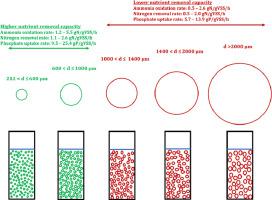Water Research ( IF 11.4 ) Pub Date : 2021-04-04 , DOI: 10.1016/j.watres.2021.117119 Bao Nguyen Quoc , Maxwell Armenta , John A. Carter , Robert Bucher , Pardi Sukapanpotharam , Samuel J. Bryson , David A. Stahl , H. David Stensel , Mari-Karoliina H. Winkler

|
An aerobic granular sludge (AGS) pilot plant fed with a mixture of acetate amended centrate and secondary effluent was used to investigate the optimal granule size range for simultaneous nitrification and denitrification (SND) and ortho-phosphate removal. The anaerobic phase was mixed to understand how AGS will perform if integrated with a continuous flow activated sludge system that cannot feed the influent through the settled sludge bed. Five different granule size fractions were taken from the pilot (operated at DO setpoint of 2mgO2/L) and each size was subjected to activity tests in a well-controlled lab-scale AGS reactor at four dissolved oxygen (DO) concentrations of 1, 2, 3, and 4 mgO2/L. The size fractions were: 212 – 600 µm, 600 – 1000 µm, 1000 – 1400 µm, 1400 – 2000 µm, and >2000 µm. The smallest size range (212 – 600 µm) had the highest nitrification and phosphate removal rates at DO setpoints from 1 – 3 mgO2/L, which was attributed to the higher aerobic volume fraction in small granules and hence a higher abundance of phosphorus accumulating organisms (PAO) and ammonia oxidizing bacteria (AOB). In comparison, large granules (>1000 µm) had 1.4 – 4.7 times lower ammonia oxidation rates than the smallest size range, which aligned with their lower AOB abundance relative to granule biomass. The granules with the highest anoxic volume fraction had the highest abundance of nitrite reductase genes (nir gene) but did not show the highest specific nitrogen removal rate. Instead, smaller granules (212 – 600 and 600 – 1000 µm), which had a lower nir gene abundance, had the highest specific nitrogen removal rates (1.2 – 3.1 times higher than larger granules) across all DO values except at 4 mgO2/L. At a DO setpoint of 4 mgO2/L, nitrite production by ammonia oxidation (ammonia monooxygenase) exceeded nitrite reduction by nitrite reductase in granules smaller than 1000 µm, in addition, some denitrifying heterotrophs switched to oxygen utilization in deeper layers hence suppressing denitrification activity. At the DO range of 2 – 4 mg/L, granular size had a greater effect on nutrient removal than DO. Therefore, for AGS developed at an average DO setpoint of 2 mgO2/L, selecting for size fractions in the range of 212 – 1000 µm and avoiding DO values higher than 3 mgO2/L can achieve both a higher nitrogen removal capacity and energy savings. This study is the first to investigate the influence of different DO values on SND and biological phosphorus removal performance of different aerobic granular sludge sizes.
中文翻译:

同时去除氮和磷酸盐的最佳颗粒污泥尺寸研究
一个好氧颗粒污泥(AGS)中试设备,用乙酸盐改良的浓缩液和二级流出物的混合物供料,以研究同时硝化和反硝化(SND)和正磷酸盐去除的最佳颗粒尺寸范围。混合厌氧阶段以了解AGS与连续流活化污泥系统集成后的性能如何,该系统无法将进水通过沉降的污泥床供入。从中试中提取了五种不同的颗粒大小分数(在DO设定为2mgO 2 / L的条件下进行操作),并对每种大小的颗粒在4种溶解氧(DO)浓度为1的良好控制的实验室规模AGS反应器中进行了活性测试。 2、3和4 mgO 2/升 尺寸分数为:212 – 600 µm,600 – 1000 µm,1000 – 1400 µm,1400 – 2000 µm和> 2000 µm。最小尺寸范围(212 – 600 µm)在溶解氧设定值(1-3 mgO 2 / L )下具有最高的硝化和磷酸盐去除率,这归因于小颗粒中有氧体积分数较高,因此磷积累量较高生物(PAO)和氨氧化细菌(AOB)。相比之下,大颗粒(> 1000 µm)的氨氧化速率比最小尺寸范围低1.4 – 4.7倍,这与其相对于颗粒生物质的较低AOB含量相符。缺氧体积分数最高的颗粒具有最高的亚硝酸盐还原酶基因(nir)含量。基因),但没有显示出最高的比氮去除率。取而代之的是,nir基因丰度较低的较小颗粒(212 – 600和600 – 1000 µm )在所有DO值中具有最高的比氮去除率(比较大颗粒高1.2 – 3.1倍),但4 mgO 2 / L. 在DO设定值为4 mgO 2 / L时,小于1000 µm的颗粒中氨氧化(氨单加氧酶)产生的亚硝酸盐超过亚硝酸还原酶对亚硝酸盐的还原,此外,一些反硝化异养菌转换为更深层的氧气利用率,从而抑制了反硝化活性。在DO范围为2-4 mg / L时,颗粒大小比DO对营养去除的影响更大。因此,对于以2 mgO的平均DO设定值开发的AGS2 / L,选择尺寸范围为212 – 1000 µm的颗粒,并避免DO值高于3 mgO 2 / L可以实现更高的脱氮能力和节能效果。这项研究是首次研究不同DO值对不同好氧颗粒污泥尺寸的SND和生物除磷性能的影响。









































 京公网安备 11010802027423号
京公网安备 11010802027423号